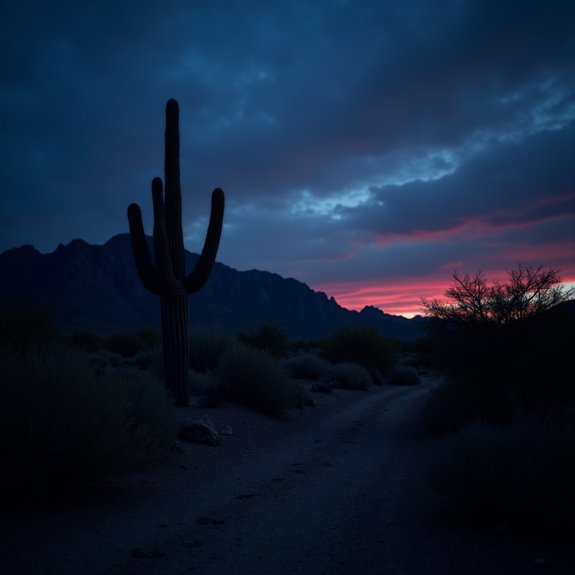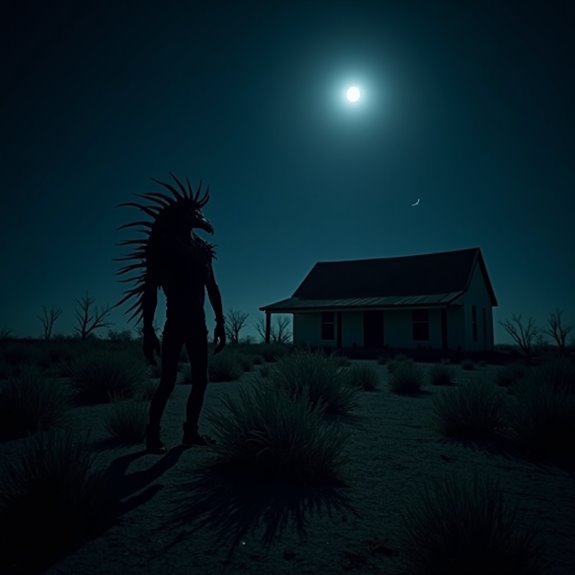Does the Chupacabra Still Haunt the Southwest?
The Chupacabra, a creature that emerged in Puerto Rico in 1995, still captures attention in the Southwest. Recent sightings and livestock attacks have reignited interest and speculation. Locals and visitors often exchange stories about eerie encounters, while festivals celebrate its lore. But what drives this persistent fascination? Are there new explanations for the creature’s myth, or is something more enigmatic at play? The answers may not be as clear as one might think.
Introduction

Though it first emerged in Puerto Rico, the Chupacabra legend has spread across the Southwest, capturing the imagination of locals and tourists alike. This mysterious creature, often described as a hairless dog or reptilian entity, reportedly preys on livestock, particularly goats. Many eerie tales of animal mutilations have fueled the mythology, leading to sightings throughout Texas, Arizona, and New Mexico. Folks have shared personal accounts of encounters, fueling curiosity and skepticism. As a result, numerous festivals and events celebrate the legend, drawing enthusiasts who seek to uncover the truth behind these chilling stories. The Chupacabra’s allure lies in its blend of folklore and fear, making it a haunting symbol of the region’s rich tapestry of supernatural lore.
Chupacabra’s 1995 Puerto Rico Emergence

In 1995, the Chupacabra first captured public attention in Puerto Rico when a series of strange livestock deaths sparked outrage and fear among farmers. Reports surfaced of bloodless goats and peculiar bite marks, which led locals to speculate about a mysterious creature lurking in the shadows. The phenomenon caught the media’s eye, with sensational headlines stoking public intrigue. Videos and eyewitness accounts emerged, detailing encounters with a small, alien-like figure with spikes along its back. As the incidents escalated, conspiracy theories blossomed, suggesting government experiments or extraterrestrial involvement. This initial wave of sightings firmly cemented the Chupacabra into popular culture, marking the beginning of its legend and turning Puerto Rico into a focal point for cryptozoological enthusiasts worldwide.
Notable Cases or Sightings

The legend of the Chupacabra gained traction through various notable cases and sightings across the Southwest. In 2003, a rancher in New Mexico reported finding dead goats drained of blood, igniting speculation about the creature’s presence. Just a year later, in Arizona, several witnesses claimed to have spotted a hairless, reptilian creature lurking near livestock. These accounts drew media attention, prompting enthusiasts and researchers to investigate. In 2017, a Texas woman recorded an unusual animal outside her home, claiming it matched the Chupacabra’s eerie description. Sightings continued to surface, with reports from as recently as 2021. Each story added fuel to the fire, expanding the mythos surrounding the elusive creature and fascinating countless individuals intrigued by the unknown.
Common Theories or Explanations
As sightings of the Chupacabra proliferated, various theories emerged to explain the creature’s existence. Some suggest it’s a new species, possibly a hybrid of canines, like coyotes, and other animals affected by diseases such as mange, which alters their appearance. Others argue it’s a manifestation of cultural folklore, a modern myth reflecting community fears surrounding livestock predation. Additionally, some researchers believe it’s a result of misidentified wildlife, including raccoons or stray dogs. Paranormal enthusiasts claim the Chupacabra is an extraterrestrial being, sent to Earth for unknown purposes. Each theory speaks to society’s struggle to explain the unknown, with the Chupacabra becoming a symbol of both fear and curiosity about nature’s mysteries.
Frequently Asked Questions
Are There Any Recent Sightings in Arizona or New Mexico?
Recent reports have emerged of potential Chupacabra sightings in Arizona and New Mexico. Locals claim strange animal behaviors and unexplained livestock deaths, sparking renewed interest and debate about the creature’s existence in these areas.
What Do Local Legends Say About the Chupacabra?
Local legends describe the Chupacabra as a mysterious creature that preys on livestock, especially goats. They suggest it’s a sinister being, often depicted with sharp fangs and glowing eyes, haunting rural areas under the cover of darkness.
Have Scientists Studied the Chupacabra Phenomenon?
Scientists have studied the chupacabra phenomenon, examining sightings and physical evidence. They’ve often attributed the creature to misidentified animals or folklore, but enchanting tales keep the mystery alive, fueling ongoing debate and interest in the elusive creature.
What Animals Are Often Mistaken for the Chupacabra?
Many animals, like coyotes, raccoons, and dogs, often get mistaken for the Chupacabra. Their unusual appearances, especially when sick or emaciated, can lead observers to misidentify them as this legendary creature haunting folklore.
Is There Any Official Government Investigation Into Chupacabra Sightings?
Government agencies haven’t officially investigated Chupacabra sightings, as most cases receive skepticism. Instead, locals often report their encounters, while researchers focus more on identifying misidentified animals rather than confirming the legend’s existence or validity.


